#athens greek culture Benaki Museum
Photo
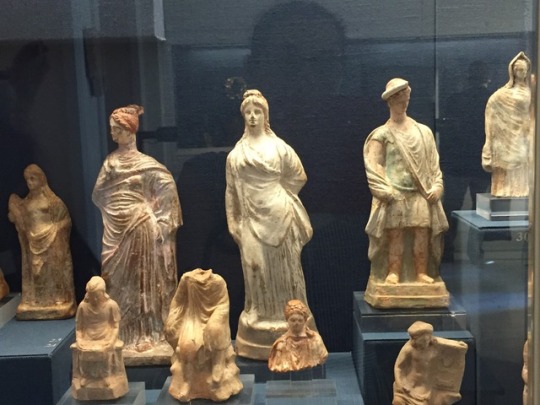



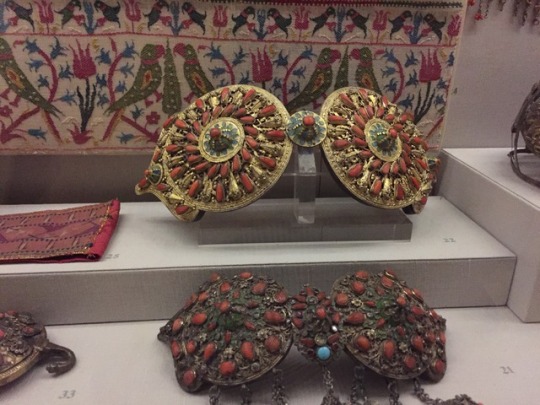
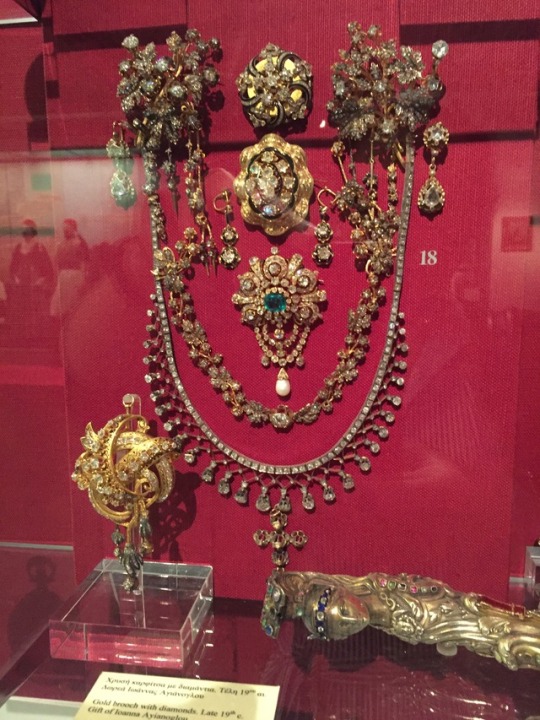

Some of the treasures from the Benaki Museum in Athens, which houses items from the pre-historic to the modern times, and has a great restaurant, see cuttlefish and potato dish. The museum even includes two very ornate 18th century reception rooms from Macedonia.
1 note
·
View note
Text
Yiannis Psychopedis: Heroes of '21 Athens Greece
Yiannis Psychopedis: Heroes of ’21 Athens Greece
Jannis Psychopedis Kavafi – Piasa
Feeling a bit disconcerted during my last few days in Athens, I went to view Jannis Psychopedis’ Exhibition Heroes of ’21. The exhibition includes the artists’ most recent paintings, engravings, and drawings “created during long months of covid lockdown”. His works are “inspired by thoughts and contemplations triggered and creatively brought into being by the…

View On WordPress
#1960s “A” Artistic Team in Athens#Athens School of Fine Arts#Athens Visual Arts Centre#Benaki Museum#City of West Berlin Cultural Programme#Epitheorisi Technis Magazine#Filiki Eteria (Society of Friends)#Jannis Psychopedis#Jannis Psychopedis Painting Meets Poetry#Jannis Psychopedis’ Exhibition Figures of ’21#Lord Byron#Munich Academy of Fine Arts#Museum of Philhellenism#Philhellenes#Philhellenic Movement#SNFCC#Stavros Niarchos Foundation#Stavros Niarchos Foundation Cultural Center#Young Greek Realists Group
4 notes
·
View notes
Link

Organised annually as part of the Athens Photo Festival, the exhibition Young Greek Photographers features a juried selection of artists between 18-35 years old. The selected artists are then exhibited at the festival, which took place this year at the Benaki Museum’s Pireos Street Annexe. Fourteen emerging photographers have been included in this year’s show covering a wide spectrum of photography, from documentary to abstract. Several of the artists presented follow a staged approach, setting up their props and models to create imaginative and surreal scenes. Others have travelled far and wide to capture events and situations across the world, like an anarchist utopia in the west of France fighting against the government to a small indigenous tribe in Ecuador resisting oil drilling and the exploitation of nature. Greek landscapes, local social issues and the ever-recognisable Athenian urban sprawl feature in many of the works presented, including a macabre rapport from the destroyed area of Mati in Attica to the ennui of suburban Larisa. Keep reading for an overview of young Greek photographers to watch, as presented at this year’s Athens Photo Festival, and click on each artist’s link to see more of their work.
5 notes
·
View notes
Text
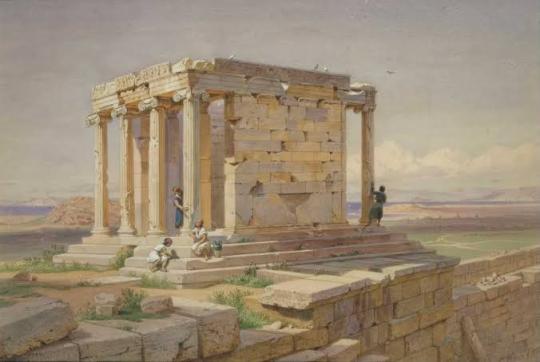
The Temple of Athena Nike. View from the North-East – Carl Werner, 1877.
🏛️Benaki Museum of Greek Culture, Athens
91 notes
·
View notes
Text
Benaki Museum of Greek Culture
Category: Europe
Address: 1 Koumbari St. & Vas. Sofias Ave., 106 74 Athens
Postal code: 106 74
Visiting Hours:
Sunday 10:00 AM - 4:00 PM
Monday 10:00 AM - 6:00 PM
Wednesday 10:00 AM - 6:00 PM
Thursday 10:00 AM - 11:30 PM
Friday – Saturday 10:00 AM - 6:00 PM
Wait time (Yes / No)
No
Time you can spend here
1-2 hours
Must see
Library
Byzantine Art
Collection of Drawings, Paintings, and Prints
Roman Art, Prehistoric, Ancient Greek
Historic Heirlooms
Entry Fee
Full Ticket Charges
Temporary Exhibition = € 8
Full Admission = € 12
Reduced Ticket Charges
Temporary Exhibition = € 6
Full Admission = € 9
Journalists = € 1
Free Open Hours
Excluding Guided visits, organized tours, 18th May, which is celebrated as the International Museum Day, there is free admission in the museum from 6:00 pm to 12:00 am, every Thursday.
Reduced entry fee
People who are eligible to enter in the Benaki Museum of Greece Culture at reduced entry fee are listed below:
Members of Hellenic Chamber of Fine Arts
European Youth Cardholders
Archaeologists
Students
Teachers
Persons over 65
Hellenic Ministry of Culture cardholders
Conservators
Free entry
People who are eligible to enter in the Benaki Museum of Greece Culture for free are listed below:
Unemployment Cardholders
Members of Benaki Museum
For disabled persons
Friends of the Benaki Museum
Persons under 22
ICOM members
Guides
Combined Tickets
There is a 20% discount on the entry fee for temporary and permanent exhibitions.
The combined ticket of €25 ticket, named “The Benaki Museum Experience” allows the visitors to enter the museum buildings once in a day for the next three months. However, the “Leigh Fermor House”, and the “Valadoros Collection” are ineligible for this offer.
How To Reach From City Center/ City Square/Airport To Attraction
Buses
You can book your rides in the following Buses to reach at your destination.
022, 100, 054, 204, 203, 732, 220, 221, 608, 224, 235, 622, 815, Ε6, Γ5, Α5, Ε14,
Trolley Buses
3
Metro
Follow the METRO lines 2, and 3 from EVAGELISMOS and SYNTAGMA stations
Tip For Visitors
The location mentioned above is the main museum.
A significant number of visitors also visit Annex, which is just a few meters ahead, must-visit there too.
Do not miss the food from the main cafeteria, this is an exquisite place to eat and chill out.
Book your tickets online from the official website of the Benaki museum
There are two convenient locations are available for storage and lockers in Athen, just opposite to “Syntagma and Monastiraki metro stations”.
Don’t miss the chance to get a 20% discount by purchasing combined tickets.
Attraction Writeup
The Benaki Museum of Greek Culture is located among the wonderful, and eye-catching neo-classical structures in Athens. It is close to the Hellenic Parliament, and National Garden. Antonis Benaki and his sisters, Argine, Penelope, and Alexandra has donated this museum for the Greek nation. However, this was further changed over into an exhibition hall to protect the collections of Antonis Benakis. Moreover, this museum building shows the historic architectural creativity and reflects the greek ancient culture. Although, by following its latest restoration which was done between 1989 - 2000, the building structures incorporate an interesting and unique exhibition on Greek Cultural assets diachronically from ancient times to the twentieth century.
The main tourist attraction of this museum is the reflection of ancient greek architecture in the building complex. The main development and modification has completed in 1911 by Anastasios Metaxas. After that, Emmanuel Benakis, and Antonis' father has owned its ownership from Anastasios Metaxas in the mid of the twentieth century. The museum building was further furnished including an outside stairs and a Doric patio for marble paving the way to the Vass, the Sofias Ave, front entrance just as the fundamental façade ornamentations. Moreover, the next renovation and expansion was done in the year 1930 to change the building into the museum gallery of Antonis Benakis. This gallery includes the collection of Greek arts alongside the vast collections of Chinees ceramics.
Additionally, in the years of 1965, 1968, and 1973 some of the most amazing upgradations has been done in the museum gallery collections including ancient arts, greek paintings, and drawings, and many more. However, the remodeling of museum building between the years 1989 to 2000 has proved to be a valuable addition to the beauty and attraction of the Benaki Museum in terms of their Greek arts, and material culture. Moreover, the "Spyridon and Eurydice Costopoulos Gallery" has well increased the number of visitors to this place because of its temporary exhibitions, the fully operational Library services, and museum operational historical places.
3 notes
·
View notes
Text
Kalimera! Something to eat?
Greek hospitality means food. It taste like kalamata olives, fresh, sweet figs and strong, delicious olive oil, not to forget the soft grapes that torn you between harvesting them for the next delicious sip of House White versus indulging yourself in them straight out from the vine.
There are certain musts you should try in Greece (if you haven’t done so in Turkey or in Georgia) like Tomatokeftedes or sun dried tomato croquettes, Greek Fava Dip, that delicious yellow split pea puree, feta cheese in one of their multiple, exquisite special preparations, meat filled zucchinis and tons, tons of wine to pair with all of it.

I gained almost 2 kilos in 2 weeks, - thank god I was prepared and I lost weight before traveling - but no regrets nor harm feelings: those were the best 2 kilos I gained in a while. All the beauty and history surrounding you deserve a proper celebration, and when it comes to commemorate something, Greeks know exactly how to do it. A little bit of cheese, some home made pies or veggie croquettes, you name it. And that is just for starters.
We took this hospitality really seriously, and as my friend Mau would say, we knew our “priorities”, so FOOD became a crucial part of our experience and tour. The heat also made it easier for us to stop every 2 hours for a soul refill- since when we ate, we were happy. Here’s the recap of our favorites places went in Athens:
Diongenes
Lisikratous, Athina, 105 58

It was our first dinner and we were both starving: Mau from flying 10+ hours from the future and myself flying almost another 10 from the past. Luckily, this restaurant which we researched before and was recommended to us, was around our place. It was a gorgeous taverna. Exactly as you would imagine a mild night in Greece might be like. We ordered some zucchini, tomato croquettes and an octopus, which seemed to be more tasty than what they usually and actually were given our flight famine. But still, the place is worth giving it a shot since the ambience and the service is very, very good.
Kayak
Durrachiou 30 & Amvrakias
Athina, 10443

It wasn’t a brilliant idea, to be honest, to have a kick-in-the-butt-awaken Ellinikos or Greek Coffee that night instead of a regular espresso. Same as in Turkish culture, their coffee is extremely strong, heavy and with the grounded bean in it so it has this dusty and dry taste. Strong. Killer. Not at all jet-lag helpful. Worth it, though? Absolutely!
Everest
various locations
Bites&Kms Fav: Syndagma Square, Athina, 105 63
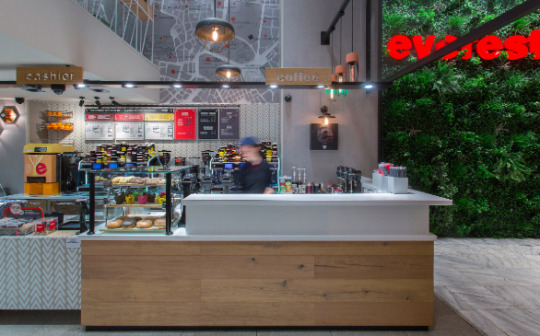
photo courtesy of polyarch.com
We found this place by chance and, oh, odds are in our favor! Since that moment, each time we needed a refilled, we stoped by the closest Everest we could find in seek for an orange juice or a cappuccino. Cheap, delicious, great service. Tons of food and snack options to go along, even at this store on Syndagma Square, freshly made pizzas, sandwiches and croque monsieur were available!
Klepsydra Tavern
Klepsidras, Athina 105 56
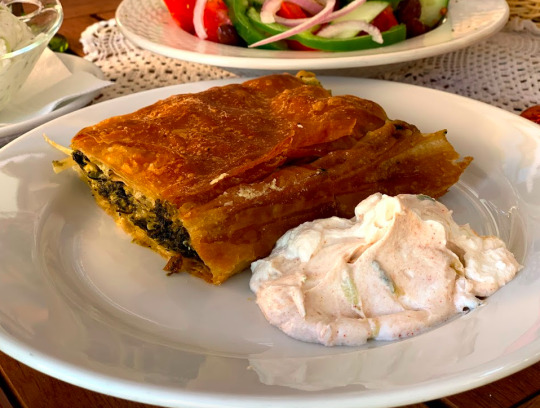
Finding this secret gem was pure coincidence but once again, we ended up in the most wonderful corner in between Plaka and Anafiotika. There was only one table left, with a “reserved” sign on it, and as soon as we mentioned we were there for lunch, they remove it, reverse their glasses and brought the bread. It was meant to be. The view, the service and the food was all perfect. We ordered some of our favorites: spanikopita, tzaziki and greek salad. Spanikopita or otherwise known as Greek spinach pie is a traditional yet delicious recipe. With its versatility the dish matches with every time of the day. Feta cheese, butter, olive oil all are mixed and baked until golden crispy perfection.

Greek salad is a must have for Greeks with almost every meal. Choriatiki, as they called them in Greek, are made of tomatoes, olives, cucumber and a large piece of feta cheese and served undressed. Dressing is left at person’s choice hence all restaurants serve vinegar, salt, pepper and olive oil with the salad - although, in our experience, most of the times, it came already prepared. With the tradition of being a starter, Greek salad can also be a great side dish. Look at this beauty! We were definitely in food heaven!

Stamatopulos Tavern
Lisiou 26, Athina 105 58

At night, we had a reservation on this place a Greek friend recommended. A little bit touristy yet fun, the only regret was that a couple came in after us and sat super close to our table, and started smoking non-stop, which became really annoying. Yet, there was nothing left to do, since it was an al fresco dinner place. Regardless, it was a lovely evening. They had live music with the traditional guitar and two guys with the typical voice you expect from the Greek coasts. The highlight of the night, aside from the great Moussaka, a lemon dressed lamb and some more croquettes, it was the time the musicians start playing the amazing Zorba Song! I couldn’t help myself and stood up, went to the front, and tried to learn that beautiful dance. After a while, right next to a two-left-legged old guy, I managed to do something, but the highlight of the night was when Mau joined and we killed the dance floor, throwing shame to all the other not-so-gifted people with our grace and moves!
Coming back to the food, the moussaka is a legendary, traditional dish that is creamy and juicy. Moussaka is served in almost all tavernas in Greece. In the big family gathering this dish is prepared by Greek homemakers. In Moussaka, tomato sauce is used to cook minced beef which is subsequently layered with sweet eggplants and creamy béchamel sauce. This irresistible cuisine is filling so you don’t need too many side dishes. I was a little bit skeptical about moussaka at first since the ones I had before weren’t that good, but this one, OMG, completely changed my mind about them!
Brettos
Kidathineon 41, Athina 105 58
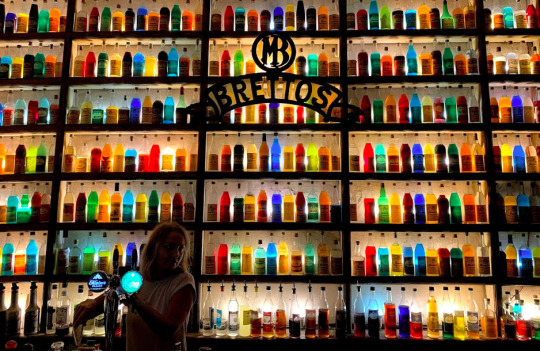
Brettos is Athens’ oldest bar and distillery, established by Michail Brettos in 1909. Most of the alcohol served there such as ouzo, mastiha, liqueurs and other beverages, are home made and they still respect the old recipe from Mr. Brettos. You can taste them are feel the fermentation happened in the old oak barrels placed inside. As soon as you step inside Brettos, you will be amazed by the wall adorned with colorful glass liqueur bottles and impressive original wooden barrels. Its unique décor is probably one of the reasons why Brettos is one of the most photographed locations in Athens, behind the Acropolis, Syntagma Square and other ancient monuments and sites in the city. We had two strong and delicious drinks: Aphrodite, which was ouzo gold, raspberry liquor, pink grapefruit soda and mint leaves and the one called Sea Breeze, made with Gin, fresh lime, fresh orange cubes and soda. Guess who got what ;)
Acropolis Museum Café
Dionysiou Areopagitou 15, Athina, 117 42

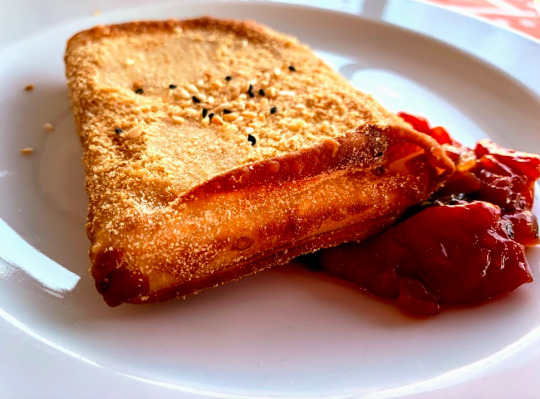
When researching about the Acropolis, when to go, how to get tickets, etc, etc, the obvious question of “is the Acropolils museum worth a visit?” pops up. It is if you are super into history. Its greatly display showcases all the valuable stuff they removed from the Acropolis seeking for preservation. But, if you are like me and decide to go just for the real ruins per se avoiding an overflow of information, then the Acropolis and the other monuments spread out around Athens should do the trick. Although, there’s one thing not so many sites mention, and is that the Acropolis museum has a terrific terrace where to contemplate the Parthenon and a delicious seasonal menu to go with the view. We had some eggs, two delicious cappuccinos and the fantastic feta me meli - another Greek food dish that can be tasted as dessert or an entrée. Feta is wrapped in filo pastry before oven baked and honey is drizzled over it. The optimum balance between salty feta and sweet honey creates a mesmerizing taste. They served it with a tomato jam on the side instead of the honey and was absolutely delicious.
Da Vinci Ice-cream
various locations
Bites&Kms Fav: 4 Selley Street, Athina, 10558

Play it safe, avoid a heat stroke: have an ice-cream! And if it’s a gelato, even better. The creative cone flavors at Da Vinci match the delicious and unique ones from the gelatos so be sure to pick wisely, or come again and again to try them all!
Thea Terrace
Rooftop of Central Hotel
Apollonos 23, Athina, 105 57

This was another fantastic, last minute Mau finding. It was so great, we ended up going twice. Close to Plaka but far enough from the crowd, this boutique hotel counts with a privilege terrace and rooftop bar from where we could see the sunset. It wasnt happy hour, but the drinks were so cheap and the prosecco was so good, we had two!
Nolan
33, Voulis 31, Athina 105 57


This place is definitely unique within the fusion restaurants I’ve been to. This is truly a delicious blend in between Greek, Asian and German cuisine, all the influences its owner has ingrained. As a Michelin recommendation, we left it aside pursuing Greek traditional tavernas, but it happens that after a while, you’re craving for something different like a burger or some pasta. What you don’t actually know is that what you need is a stop by Nolan. Once again, wondering in what we thought was a new, orthodox neighborhood, we ended up by its corner and its name rang a bell. We went in during a sunny Greek noon and we were lucky they were able to sit us regardless of not having a reservation. Minutes after, the restaurant got full, local artists started playing music on the streets and we were having a true fusion feast. We had some marinated tuna, a delicious octopus salad and some lamb dumplings. It was amazing, a must stop during your stayed in Athens.
Taf Coffee Shop
Emmanouil Benaki 7, Athina 106 78
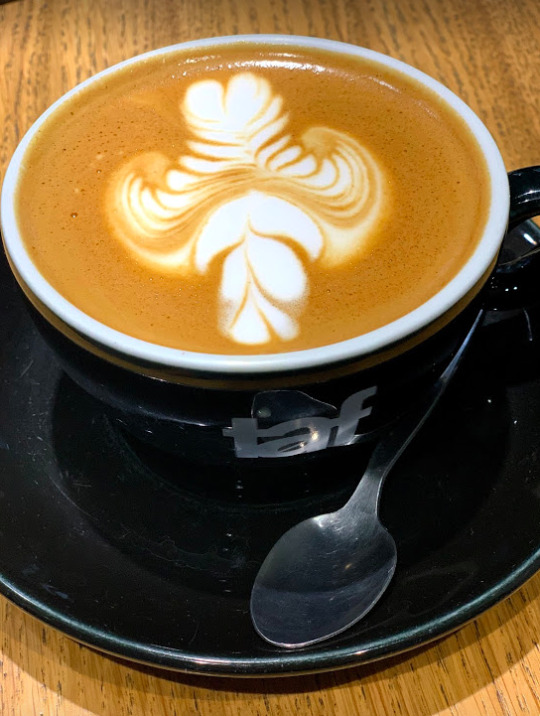
This is one of the top coffee places I’ve ever been to. Not because its price, look or location, but because of the love and passion they put on each brew. This is how they described their daily special - hence, the coffee of my choice: “Rosebud double shot cap creaming feeling, smooth body caramel chocolate and nutmeg aroma. Taste of cherry and caramel with apricot tangerine and almond nuts.”
Mind the Cup
Emiliou Veaki 29, Peristeri 121 34

I took the train to Peristeri, just outside Athens, to check out what according to Buzzfeed “one of the coffee shops around the world you must check out before you die” Happily, it didnt disappoint. Not only the little town is super cozy, where I got a pair of amazing leather boots, but also, took the morning to write and to enjoy this wonderful plaza where Mind you Cup is located. It reminded me of old Montevideo, the city where I was raised when I was younger. I keep specifying this time and space issue since nowadays it’s quite different. It also reminded me of an out-side the tourist epicenter mini towns around the north of Spain or outside Porto, in Portugal. Even a “ciudad del interior” or countryside town from Uruguay. Even the tree to which shadow I was sitting and enjoying, was the same Willow tree I had at my school. It was a beautiful time travel adventure, on top of the delicious European house white wine, the home made pizza and the great service from the place. The menu looks like an old and corky newspaper and is not in English, which makes the adventure even more authentic, but the gentle waitress will assist you with all your questions. People were selling their crafts and some plants, and I couldn’t resist to get an envy eye anklet. On my way back, I found this delicious and traditional dessert Greek people have for Christmas, but I could have them every day with a glass of milk. They are called Kourabiedes, a shortbread-type biscuit usually made with ground almonds, flavored with either brandy, vanilla, mastika or rose water and they are shaped into little cute balls. In the end, they are sprinkled with icing sugar and they are just to die for!
Avli - Agiou Dimitriou
Agiou Dimitriou 12, Athina 105 54
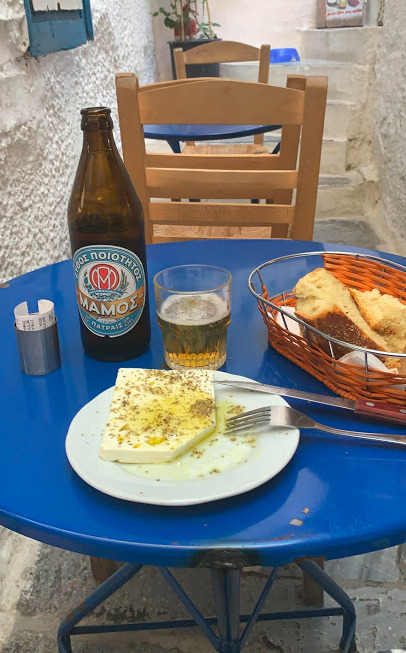

In the historic triangle of Athens there is a small tavern in a backyard called Avli which means ‘backyard’. This place is kinda secret: more and more people are accessing to its charms due to TripAdvisor’s fantastic reviews - although it still is easy to miss if you don’t go specifically looking for it. Within a small alley, behind a not so charming door, you can hear loud voices, laughs and some Greek music in the background. If you dare to go inside, disregarding your first thought of “oh, this is a private house, I shouldn't trespass it”, the scenery you will see is like it came from the ’60s. Checkered tablecloths, traditional chairs, old photos and a makeshift kitchen create an authentic feeling reminiscent of old Athens.
The always smiling owner, Takis, has operated this tavern since 1985. He pretended to know me, and after a nice “Kalimera, I remember you, please sit”, I sat down on one of the last free tables of the alley. I sat down right next to Stellios, this wonderful old man who greet me with yellow prunes, peanuts and come other spicy snack while we both waited to be served. He ordered some cheese and tomato, while I ordered the delicious feta with olive oil and some grilled peppers which were outstanding. I was so excited that I decided to copy Stellios and ordered a beer, the first Greek beer during by whole trip was waiting for me on my last day, and I ordered a Manos. It was good - that’s how far my beer knowledge and palate goes: good, not good :D To thank him for the company and the snacks, I invited him two more rounds of beer, which of course I’m not sure what happened since my Greek wasn’t that fluid so I made the best I could with Takis, so let’s hope at least some of the cash went for another Manos and the rest as tip! The whole experience was amazing, Stellios told me about his family, his lovely wife and two kids, as well as about his dog in very broken English. I showed a picture of my parents and told him I lived in New York, but that I was from Uruguay, land of football and meat. Yeap... some have Aristotles, others have Benedetti, and both of us share a Manos.
Yamas, Athens!
2 notes
·
View notes
Photo


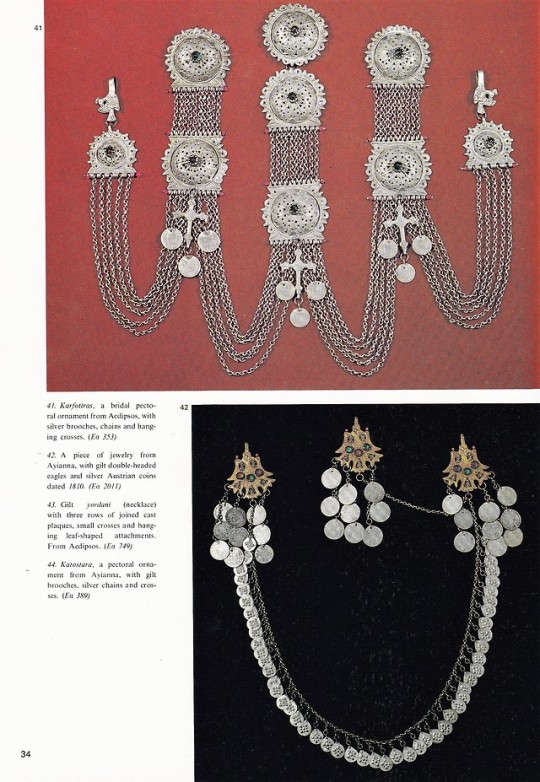
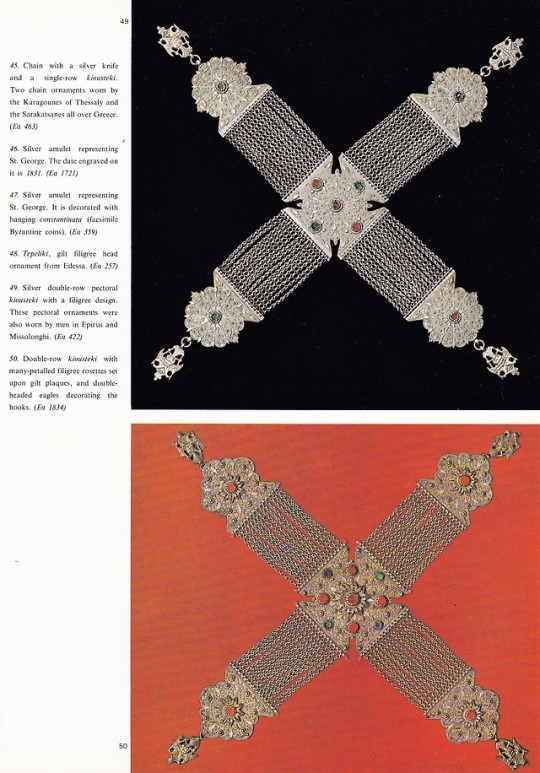


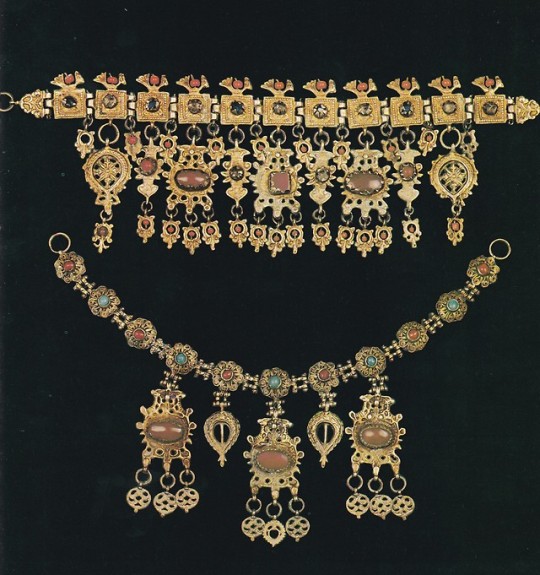
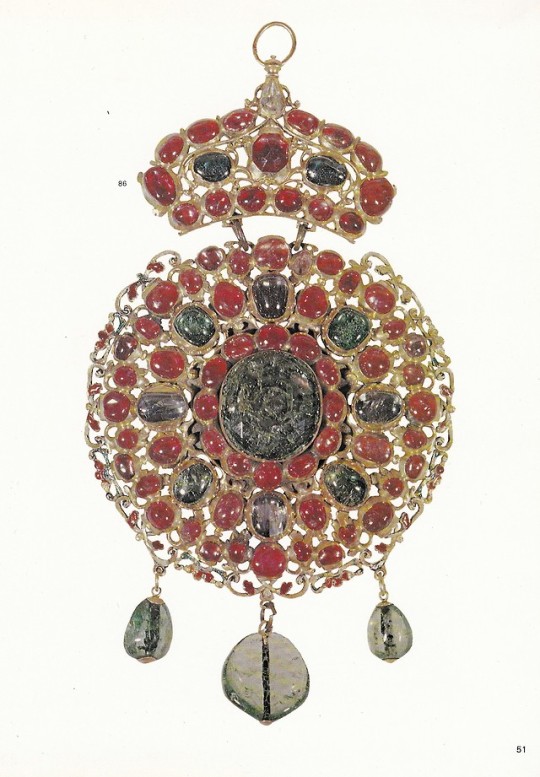

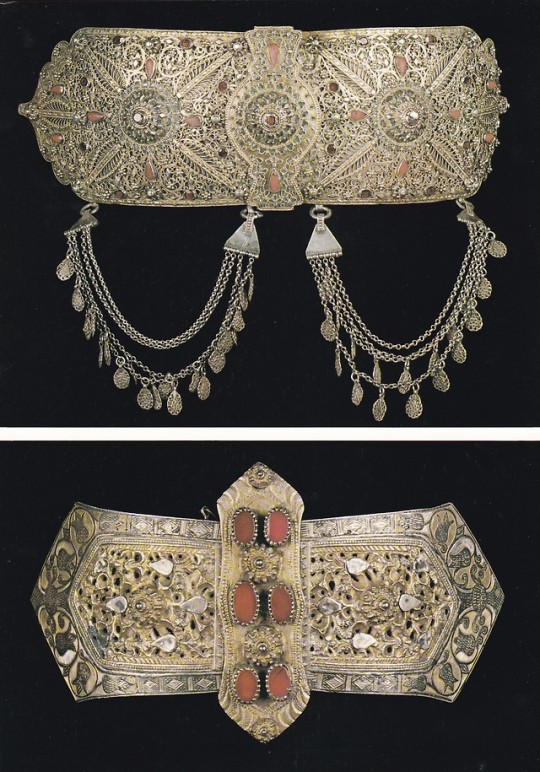
Greek traditional Jewelry
Angelos Delivorrias
Benaki Museum/ Melissa Publishing House, Athens 1980, 52 pages, 20 b/w and 66 color pictures
euro 40,00*
email if you want to buy :[email protected]
The unique treasures of the Benaki Museum in Athens, products of traditional Greek handicrafts, are presented in this exceptionally elegant publication. The Greek folk cultural tradition is reflected in earrings, bracelets, necklaces, pins, brooches, belts, crosses, diadems, etc., photographed for the first time for this book. The combination of designs and arrangements of jewelry with costumes explains the variety of taste in different parts of Greece.
orders to: [email protected]
twitter: @fashionbooksmi
flickr: fashionbooksmilano
instagram: fashionbooksmilano
tumblr: fashionbooksmilano
#Greek traditional Jewelry#gioielli greci#Benaki Museum#greek folk tradition#earrings#bracelets#necklaces#pins#brooches#belts#crosses#diadems#jewelry books#fashion books#fashionbooksmilano
2 notes
·
View notes
Text

Athens, Greece — Last day in Athens for a few weeks before we head off to the islands. Took care of errands this morning (phone, bank, PCR). Toured the National Garden in route to climb Lykavittos Hill for a panoramic view of Athens. You could see to the sea. Visited the excellent Benaki Museum of Greek culture. This Benaki guy amassed a stunning collection where a few highlights were a 4th century gold wreath 4th; a rare mosaic of the “virgin” from Constantinople; and actual rooms from palaces of wealthy Grecians. Last stop of the day…finally…The Acropolis.


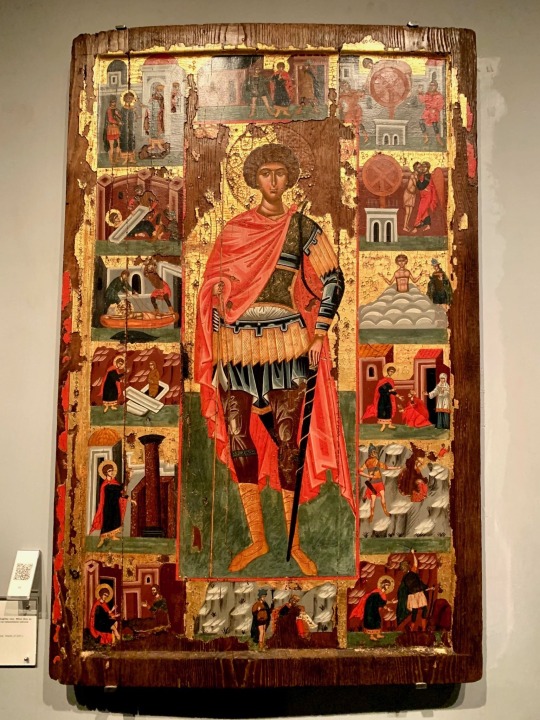
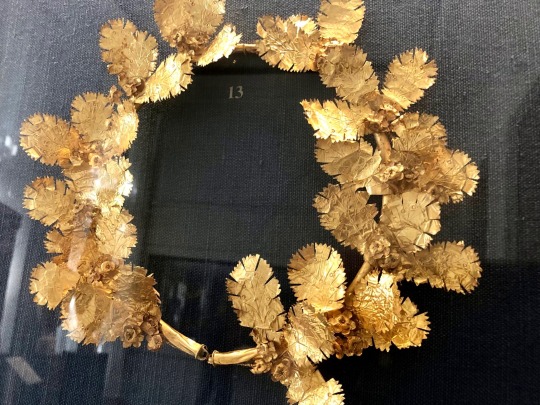

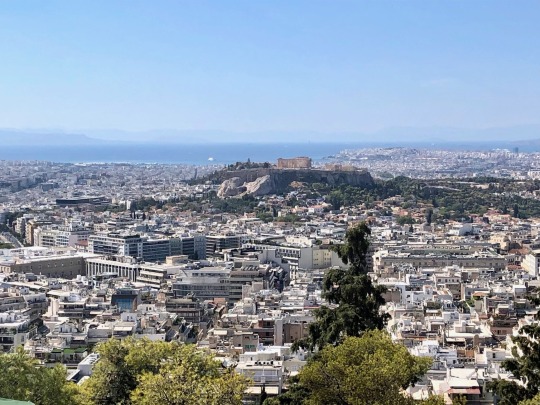
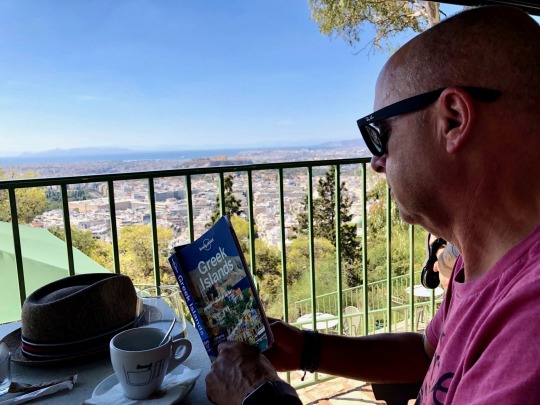

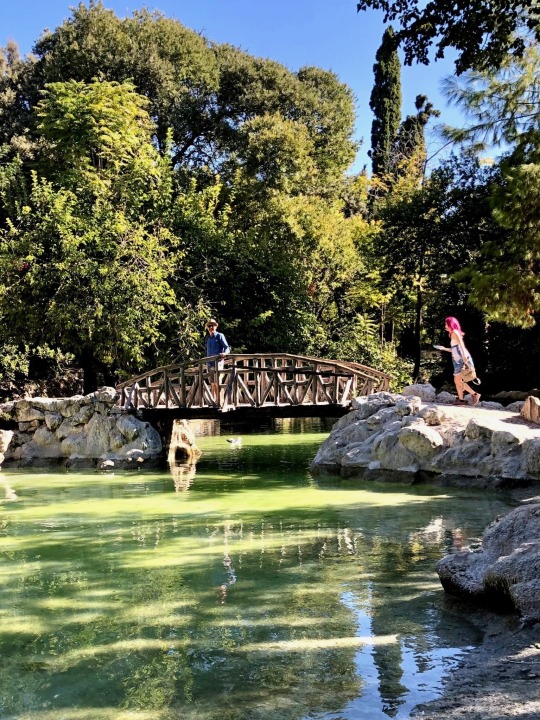
0 notes
Text
Zoumboulakis Art Gallery Athens Greece
Zoumboulakis Art Gallery Athens Greece

View On WordPress
#Art Exhibition Learn to Swim#Art Exhibition Mapping the History 1821-2021 Hydra#Athens National Gardens#Benaki Museum of Greek Culture#Chloe Akrithakis#Giorgos Avgeros#Io Angeli#Ioanna Ralli#Jacqueline Savidge#Jannis Psychopedis#Jenny Kodonidou#Kolonaki Square#Manolis Charos#Maria Filopoulou#Natassa Poulantza#Nikos Moschos#Phedon Papamichael#Roberto Cortese#Syntagma Square#Vanessa Anastasopoulou#Vassiliki Koukou#Yiannis Adamakis#Zoumboulaki Family#Zoumboulaki Gallery
2 notes
·
View notes
Text
The Prince of Wales and The Duchess of Cornwall to visit France and Greece 7th - 11th May 2018
• The tour, undertaken at the request of The British Government, will highlight the UK's strong bilateral ties with both countries;
• In France, Their Royal Highnesses will emphasise the UK and France's commitment to counter terrorism and security, education and charitable enterprise as well as the country's rich history in the areas of food and viticulture;
• In Greece Their Royal Highnesses will celebrate the UK and Greece's longstanding maritime and military relationship, youth opportunity, charitable and education connections;
The Prince of Wales and The Duchess of Cornwall will start the visit in Nice, where they will commemorate the attack which took place on Le Promenade des Anglais in July 2016. The Prince and The Duchess will also attend a reception to celebrate the longstanding links between Nice and the UK, including the fact that Her Majesty Queen Victoria regularly visited the city throughout her lifetime.
In Lyon Their Royal Highnesses will jointly attend a VE Commemoration to mark 73 years since the end of the Second World War in Europe.
His Royal Highness will visit The International Police Organization (INTERPOL) to highlight the UK and France's role in international police cooperation. Their Royal Highnesses will also attend an event to celebrate the city's rich culinary history.
Lyon hosts France's second largest student population, and His Royal Highness will visit the ISARA University specialising in agronomy (the science of using plants for food, fuel and fibre), food and environmental studies.
The Duchess of Cornwall, a longstanding supporter of charities helping survivors of domestic violence and sexual abuse, will visit a local charity providing assistance to women.
Their Royal Highnesses will start their first official joint visit to Greece with a wreath-laying ceremony at The Monument to the Unknown Soldier, before receiving an official welcome at The Presidential Mansion and Prime Minister's Residence. Later that evening The Prince and The Duchess will attend an Official Dinner hosted by The President of The Hellenic Republic and Mrs Vlasia Pavlopoulou. The Prince of Wales will be received by The Archbishop of Athens the following morning.
During their second day in Greece Their Royal Highnesses will visit the Commonwealth War Graves Cemetery in Phaleron where His Royal Highness will lay a wreath. The Prince will then visit Piraeus for a series of engagements to celebrate the UK and Greece's longstanding maritime relationship. This will include a visit to HMC Valiant, a border-force 'cutter' currently deployed in the Aegean Sea, and working with The Hellenic Coastguard to provide security and search and rescue support.
The Prince will also visit the Averoff, a Greek armoured cruiser which forms part of The Hellenic Navy and which played a key part during the First and Second World Wars. His Royal Highness will also be able to see the HNS Olympias, a full-scale replica of an ancient Greek 'Trireme'.
The spouse of the Greek Prime Minister has invited Her Royal Highness to join her on a visit to the Benaki Museum, which showcases Greek civilisation and tradition. The Duchess will then visit the scenic Kaisariani Monastery located on Mount Hymettus overlooking Athens, where school children will be undertaking educational reading activities to mark Athens UNESCO World Book Capital 2018.
The Duchess will then visit a local shelter in Athens which provides assistance for survivors of domestic violence and sexual abuse.
Their Royal Highnesses will end their visit to Greece on Friday 11th May with a visit to Crete where The Prince and The Duchess will visit the Knossos archaeological site. Their Royal Highnesses will also visit a local charity which helps to find accommodation for migrant families in Crete, helping them to integrate with the local community.
Their Royal Highnesses will end their visit to Greece with a celebration of local produce, culture and heritage.
8 notes
·
View notes
Link
Rundown Of Activities In Athens
List of things to do in Athens
An image of Western Civilization at its generally brilliant, Athens' renowned history extends back over 3,000 years. The city prospered during old style artifact and was the origin of Socrates, Pericles, and Sophocles. Something beyond a relic of its brilliant past, today Athens is a clamoring and present day capital city and home to a portion of the nation's most significant vacation destinations. So without a delay book cheap flight tickets to Athens.
At the point when you think you've come up short on activities in Athens, invest some energy becoming mixed up in the Plaka region's tight person on foot boulevards, fixed with interesting bougainvillea-hung houses and welcoming eatery patios.
The Parthenon
Regardless of whether you couldn't care less about paleohistory or the way that in the event that it were not for the old Greeks you may be living in a far less acculturated way, you can't come to Athens and not visit the Acropolis and see the Parthenon. Indeed I realize that there are really Athenians who have never climbed the means to see one of the miracles of the old world, the explanation a great many individuals go to their city, the dynamite constructing that represents probably the most noteworthy accomplishments of humanity. On the off chance that you don't do anything else on your visit to Athens, this is the one thing you ought to do.
Acroplois Museum
This stunning exhibition hall at the foot of the Acropolis' southern slant grandstands its enduring fortunes. The assortment covers the Archaic time frame to the Roman one, yet the accentuation is on the Acropolis of the fifth century BC, thought about the apotheosis of Greece's masterful accomplishment. The exhibition hall uncovers layers of history – from old remains underneath the structure, to the Acropolis itself, consistently noticeable above through floor-to-roof windows. The great worth eatery has wonderful views.
Kerameikos
This rich, quiet site is named for the potters who settled it around 3000 BC. It was utilized as a graveyard through the sixth century AD. The grave markers give a feeling of antiquated life; various marble stelae (grave markers) are cut with striking representations and recognizable scenes. It is always advisable to book low cost airlines tickets before planning for vacation.
Ancient Agora
The Agora was old Athens' heart, the vivacious center of authoritative, business, political and social movement. Socrates elucidated his way of thinking here; in AD 49 St Paul came here to win changes over to Christianity. The site today is a rich reprieve, home to the excellent Temple of Hephaistos, a decent historical center and the eleventh century Byzantine Church of the Holy Apostles, cut in block designs that emulate Arabic calligraphy. The greenery harbors winged animals and reptiles. Permit around two hours to see everything.
Benaki museum of Greek Culture
In 1930 Antonis Benakis – a legislator's child conceived in Alexandria, Egypt, in the late nineteenth century – blessed what is maybe the best historical center in Greece. Its three stories feature flawless fortunes from the Bronze Age up to WWII. Particularly flawless are the Byzantine symbols and the broad assortment of Greek territorial ensembles, just as complete living rooms from Macedonian manors, complicatedly cut and painted. Benakis had such a decent eye, that even the horticultural devices are delightful.
National Archaeological Museum
Lodging the world's best assortment of Greek ancient pieces in a huge neoclassical structure, this exhibition hall is one of Athens' top attractions. Fortunes offering a perspective on Greek workmanship and history – dating from the Neolithic time to Classical periods, remembering the Ptolemaic time for Egypt – incorporate choice figures, ceramics, adornments, frescoes and ancient rarities found all through Greece. The delightfully introduced shows are shown essentially specifically.
Stavros Niarchos Foundation culture center
Sitting underneath a man-made slant above Faliron Bay, and concealed by an 'Enchantment Carpet' rooftop secured with sun oriented boards, this staggering Renzo Piano structure, finished in 2016, is home to the Greek National Opera and the fundamental part of the National Library. It's encircled by a lovely large park and has a noteworthy scope of occasions and shows, a few of which are free.
Ergon House Agora
A magnificent expansion to Athens' culinary scene is this shop, bistro and café possessing a beautifully planned chamber space overflowed with light. There are isolated territories for a greengrocer, fishmonger, butcher and bread shop, in addition to racks pressed with top-quality Greek items sourced from little scope makers around the nation. You'll eat well here and, in all likelihood, leave loaded down with treats.
Museum of Islamic Art
While not especially enormous, this gallery houses a critical assortment of Islamic craftsmanship. Four stories of a house show, in rising sequential request, astoundingly wonderful weaving, adornments, porcelain and even a marble-amazed banquet hall from a seventeenth century Cairo manor. Instructive signage gives the detail on what you're seeing. In the storm cellar, some portion of Athens' old Themistoklean divider is uncovered.
Varvakios Agora
A brilliant sight in its own right, this colossal old fashioned iron market corridor is committed to fish and meat, particularly endless supply of sheep remains, hanging in scarcely EU-agreeable glass cases. Tavernas inside the market, many open day in and day out, are an Athenian foundation for aftereffect busting patsas.
Underflow
Work in Greek vanguard rock and dark sounds, this is one of Athens' top record shops. It stocks a wide scope of music sorts on vinyl and CD, both new and used. It's additionally a craftsmanship exhibition, bistro and, on Friday evenings, a presentation space – check the site to see who's playing.
Zacharias
A Greek-Spanish couple having some expertise in silkscreen structures roused by old style themes. Particularly pleasant are their calfskin note pads, wallets and the sky is the limit from there, where dark ink on the common stow away echoes the shades of old earthenware. A portion of their stir appears in historical center shops, yet this retail facade and workspace has the best determination.
So here the list of most important places you should definitely visit whenever you make an idea to go to this beautiful place. Book online flight reservation today and explore the world !
Cheap Flight Tickets to Athens, Tourist Attractions in Athens, Vacation Packages for Athens, best vacation destinations in Athens
#Cheap Flight Tickets to Athens#Tourist Attractions in Athens#Vacation Packages for Athens#best vacation destinations in Athens
0 notes
Text
ethnography / field research
July and August 2019 I visited events, gatherings, interactive installations and presentations that informed me about what others were/are doing with regards to the field I am working in. Here I share findings from a few of them:
Immersive walk: Tracing Erased Memories: A Parallel walk of London and Cairo
(By the NarrativeCollective) Immersing the viewer in two cities at once, this work traces the political events that took place decades ago. they choose this form of communicating with the viewer to find connections and parallelisms between the two cities. This walk brought some interesting insight when it comes to screen and live interactions: the process of physically walking and digitally walking in another city adds a very interesting layer of presence vs. absence, existence in both worlds at once, and it is a valid form to consider for future designs and engaging the audience.
AudibleHag: Retelling English Folk tales through modern storytelling
This event hosted by Audible was valuable for my research for one purpose: the ‘retelling’ of old tales. Taking classic folk tales and reviving them by making them ‘current’. It made me consider what current might mean, if taking stories that took place many years ago and rewriting them to make sense today is current, then what happens to the true stories? Where they ever true?
Shubbak festival: conference talks
Writers from the Middle East, finding their identity and a new sense of what home means to them. They read extracts from their novels and told their journeys and experiences migrating. Talking to some of the writers, they gave me a sense that personal identity for them is deeply rooted into culture and religion. Through this reflection, I started talking to my Greek family about how we view religion in comparison to other cultures and ethnicities, and how closely rooted it is to our celebrations, rituals and family gatherings. This is when I started looking into belief as a form of identity, an additional factor that defines who we are.
In addition to these, I visited many photography galleries dealing with migrant identity and diaspora. I went to Athens Photo Festival 2019, hosted in the Benaki Museum in Athens, where multiple artists raised questions regarding connections with generations, objects and what happens when they are passed down to us, insider/ outsider perception, and cultural norms ‘forming’ your identity. In general terms, these events made me understand the power of photo journalism and documentary, as forms of expressing the surreal within the reality people live in. The artists act as observers yet, they have a very interesting relationship with their subject, testing the boundaries, evaluating the morality of their actions as researchers on other individuals’ lives.
0 notes
Photo

Athens is warming up as a winter destination! Here's what to expect when visiting and things to do in Athens in winter.
Athens Winter Travel Guide
Having lived in Athens for nearly five years, people often ask if winter is a good time to visit. It’s true that Athens is predominantly a summer destination, but really, it's a year round place to visit. There's always something going on, after all!
Of course, it all depends on what you are planning to do in Athens. If you're thinking of going to the beaches around Athens, winter is not the best time!
However, if you are visiting Athens for the culture, sightseeing and food, or if you just want a city break, visiting in winter is actually an interesting option. Just bring some warm clothes and an umbrella, and you will be fine. Or if you are from a Nordic country, just bring your summer clothes and pack a swimsuit too – you never know!
In this article, we show the best things to do in Athens in winter in terms of sightseeing, food, walks around the city and day trips around Athens.
Athens winter weather
Winter months in Greece are December, January and February, just like in the rest of the north hemisphere. They are typically the coldest months of the year in Greece, with January being the coldest and rainiest all around the country.
November is technically an autumn month, but it’s significantly colder than October, and minimum temperatures in Athens can reach 7C / 44F. It normally rains on one in three days. For locals, late November feels like the beginning of winter, and it’s been included in this article.
December in Athens is slightly warmer than the other winter months, but it can get quite wet, with around 12 rainy days on average. Rain in Athens can be very heavy – compared to the UK, it can be a lot stronger, and with more lightning and thunder.
Athens in winter temperature
Fun fact: Two days after I moved to Greece in February, it started snowing. I thought I moved to get away from all that stuff!!
OK – The average temperature in Athens in January is around 8C / 46F, however it’s not unusual to have below 0C / 32F. Rainfall is quite common, and there might be some snow.
February is a little drier in terms of rain, but has some of the lowest temperatures of the year. By that time, Greeks are really tired of the Athens winter weather, and can’t wait for spring.
At some point in January or February, there is typically a period of 3-4 days when the weather gets milder and sunny. These are known as the halcyon days, and according to legend this is when the halcyon birds lay their eggs.
Athens in Februrary can see some variable weather. I remember my brother visited and had T-Shirt and shorts weather. Last year, there was rain and snow.
In March, the temperature starts to rise, and you will definitely get a few sunny days, while some locals start going for a swim. That said, there has been snowfall on certain years. Global warming is really a thing!
What to wear in winter in Athens
If you are coming from colder countries, such as north Europe or Canada, you will find these conditions very pleasant.
At the same time, you probably won’t be able to get away with just a light jacket, so consider bringing warmer / waterproof clothes and an umbrella.
As the drainage system in Athens fails when rain is ongoing and heavy, consider bringing some waterproof shoes as well – they are ideal for walking around the archaeological sites and ancient marbles.
What to do in Athens in winter
Sightseeing in Athens in winter can actually be very pleasant, given that there are no cruise boat passengers and guided tours are rare.
You might come across a school visit in the main attractions, but in general that will be all. Just take note of the weather, and plan to visit the outdoors sites on sunny days and museums on rainy days.
Archaeological sites in Athens in winter
Opening hours for the archaeological sites in Greece differ between summer (April – October) and winter (November – March). In general, most of the archaeological sites in Athens are open from 8.00-20.00 in summer, and from 8.00-15.00 or 8.00-17.00 in winter.
If you are travelling to Athens in winter, make sure you check the exact opening times for each site before you visit. You can buy a combined ticket, allowing access to all the sites, for 15 euros, and walk straight in the site of your choice.
By comparison, in summer you will generally have to queue for your ticket, which will cost you 30 euros. Tip – all sites are free to visit on the first Sunday of all winter months, and are closed on 25-26 December and 1st January, so plan accordingly.
Note that the ancient marbles are very slippery, so make sure you have good walking shoes, and try to avoid going up the Acropolis hill if it’s raining.
Ancient Sites in Athens
The main archaeological sites in Athens are the following:
The Acropolis of Athens – The symbol of Athens and one of the most instantly recognizable images of Greece. The Acropolis is a large walled complex up on a hill containing several temples, of which the most famous is the Parthenon. Read more about the Acropolis here: Acropolis Guided Tour.
The Temple of Zeus – A massive temple only a 15 minute walk to the Acropolis, the Temple of Zeus is really impressive. Within the site, you can see one of the columns that collapsed in the 1850s and was never restored.
The Ancient Agora – The political, social, financial and commercial centre of ancient Athens, the Ancient Agora is a large area where you can see many ruins, including the magnificent temple of Ifestos and the byzantine church of Agii Apostoli. Within the Agora you can see the fully restored Stoa of Attalos, which used to be the equivalent of a modern mall, and is now a museum.
The Roman Agora – This is a much smaller area than the Ancient Agora, that became the centre of the city in Roman times. When you visit, make sure you spend some time to see the recently restored clock of Andronikos Kyrristos, known also as the “Tower of the Winds”.
The Kerameikos – Athens’ ancient cemetery can be found on Ermou street, a short walk from Monastiraki, Thisseio or Kerameikos metro stations. It offers a fascinating insight on burial ceremonies and other customs of the ancient Greeks. Don’t miss the museum.
Hadrian’s Library – Right outside Monastiraki metro station, this building used to host many thousands of papyrus rolls, which were sadly destroyed in 267AD, when a Germanic tribe called the Heruli invaded Athens.
Museums in Athens in winter
One of the best things to do in Athens in winter is to visit a museum or ten. Athens has over 70 museums, and you will definitely find a few that spark your interest.
If you visit museums in Athens in winter, you will meet very few crowds and will have the chance to explore the ancient artefacts with few other people around you.
Note that the opening hours for some museums are shorter than in summer, so check their website before visiting.
If you are interested in history, the best museums to visit in Athens in winter (or at any time of the year!) are the following:
History Museums in Athens
The National Archaeological Museum – The mother of all museums in Athens, it has artefacts from all periods of Ancient Greece, as well as a section on Ancient Egypt. Allow at least four hours if you want to see the National Archaeological Museum in Athens properly. Remember to take one or more well deserved breaks at the café downstairs!
The Acropolis Museum – Contains statues and other findings from the Acropolis, as well as casts of the famous Elgin Marbles. The originals can be found in the British Museum in London.
The Benaki Museum – A small, private collection of artefacts ranging from Ancient Greece to more recent times. It’s a fantastic museum if you only want an introduction to Greece’s long history. The Benaki Museum has several other branches worth exploring – check their website.
The Museum of Cycladic Art – This beautiful neoclassical building is home to one of Greece’s most unique collections of Cycladic Art. There are also sections on Ancient Greek Art and Cypriot Art, as well as a display of daily life in antiquity.
The Byzantine and Christian Museum – For most people, Greece evokes images of Ancient Greece. However, Greece has a history of thousands of years. Few people realize that the Byzantine Era lasted for around one millennium, from about the 3rd to the 13th century AD! As such, the Byzantine and Christian history is very rich. If you have a special interest in Christian art, this will be your favourite museum in Athens.
Art Museums in Athens
If you like history but are actually more interested in art, you will love these museums:
The National Art Gallery and National Glyptotheque Museum – Two buildings housing collections of artworks and modern Greek sculptures. If you are interested in art, this is probably the best museum in Athens to visit at the moment. They are located a little out of the centre in the Army Park, near Katechaki metro.
Benaki Museum, Pireos Annex – This branch of the Benaki Museum hosts up to 4 rotating exhibitions at a time, mostly to do with art and culture. It’s a lovely space, with an excellent shop and a cool café. Check their website out to see what’s going on at the time of your visit.
Museum of Greek Popular Musical Instruments – A comprehensive collection of musical instruments used in traditional Greek music. The Music Museum is one of our favourite museums in Athens!
Ilias Lalaounis Jewelry Museum in Athens – A superb collection of modern and contemporary jewelry, inspired by Ancient Greek designs.
The Herakleidon Museum in Athens – A private museum hosting rotating art / science exhibitions. Check their website before you visit to see what’s on.
Frissiras Museum – One of the few museums in Greece hosting contemporary European paintings.
There are also several smaller private galleries in Athens, generally scattered around the centre. Many of them are located in Kolonaki area.
Street Art in Athens in Winter
Walking around Athens, you will immediately notice the amounts of graffiti and street art. Athens is really a great place to spot some of the best street art in Europe – areas like Psyrri, Kerameikos and Exarchia are full of it.
There is lots of hidden meaning behind some of those artworks. You could follow this guide to Athens’ neighbourhoods, or consider a walking tour with Vanessa and explore the contemporary essence of the city.
Food and Drink in Athens in Winter
If you’ve been to Greece in the summer, chances are that you’ve had your fair share of Greek salads, fish, octopus, gyros, souvlaki, ouzo, and a few other standard dishes and drinks.
If you visit Athens in winter, however, you will discover new types of food and drink that you’ve never heard of. Read on to find out what to eat and drink in Athens in winter!
Special Food in Athens in Winter
If you visit Athens in the winter, you will get the chance to taste some dishes that you wouldn’t typically find in summer.
Don’t worry, you can still find the famous Greek salad, as tomatoes and cucumbers are grown in greenhouses nowadays. However, if you go to traditional tavernas, you might be able to find some heartier dishes that are generally regarded as too heavy for summer.
If you get the chance, try lahanontolmades (stuffed cabbage leaves), frikase (meat and lettuce stew), revithia (chickpea soup), fasolada (bean soup), fakes (lentil soup), trahanas (wheat soup), lahanorizo (cabbage and rice dish in a tomato sauce), and chicken soup.
Finally, an absolute favorite Greek winter dish that kids love is called giouvarlakia – meat balls boiled in a thick egg-and-lemon sauce.
Desserts to try in Athens during the winter
In terms of Greek winter desserts, there are some that are traditionally prepared for Christmas and New Year’s. They are called kourampiedes and melomakarona, and you can find them in pretty much every bakery and pastry shop, starting around the beginning of December.
Kourampiedes are crunchy shortbread biscuits, containing generous amounts of almonds, good quality butter and icing sugar. Melomakarona are cookies soaked in syrup and sprinkled with walnuts. Warning: eating either of these without making a mess is highly improbable!
Coffee in Athens in winter
We have written before about the coffee culture in Greece, which is pretty unique. It’s not like the French or the Italians don’t have a coffee culture, it’s just that the Greek coffee culture is really different. “Let’s go for a coffee” generally means “let’s go for a two-hour chat”, so people take their time to have a coffee, or any other drink for that matter.
There are great cafes in central Athens, such as Kimolia and Melina in Plaka area, TAF and Couleur Locale in Monastiraki, and Black Duck Garden close to Syntagma. There are also many outdoors cafes with large heaters everywhere in Athens.
The Little Kook in Athens
It’s also worth venturing to Psyrri area, to visit Little Kook café. Changing decoration every few months, it’s one of the most photographed cafes in Athens, and if you are travelling with children they will definitely love it. Be prepared to queue, especially on weekends.
All in all, sitting for a coffee is one of the best things to do in Athens in winter – take a seat, put your mobile phone away and indulge in people watching while enjoying your coffee.
Special drinks in Athens in winter – Rakomelo
If you like alcohol, there is one drink that you absolutely must try if you are in Athens in winter. It is called rakomelo, it’s served hot, and it’s made out of a strong alcoholic drink called raki, honey, cinnamon and cloves.
It’s similar to mulled wine or gluehwein, but it’s much stronger, as raki has an alcohol content of around 40%. You might not realize how strong it is until you get up from the table. Don’t say we didn’t warn you!
The best rakomelo in Athens is served in small, no-fancy places. If you are interested in enjoying this Greek winter drink, along with several Greek delicacies, consider taking a “dinner with a Greek” tour in one of our favourite places to eat in Athens.
Wine bars in Athens in winter
If all you’ve ever heard about Greek wine is retsina, it’s time to be blown away. Greece has hundreds of types of local wines that rarely make it out of the country. If you have been to Santorini, you may have tasted some, but most areas of Greece produce their own local varieties.
There are several wine bars around central Athens where you can have a lovely glass of wine with a nice cheese plate to go along. Some of the best ones are around Syntagma – any of Oinoscent, Heteroclito, By the Glass and Kiki de Grece are great choices.
Since winter calls for red, some of the Greek varieties you should familiarize yourself with are agiorgitiko, mavrotragano, xinomavro, mavroudi, kotsifali and mandilaria. Ask your waiter for suggestions, sit back and enjoy!
Special dates in Athens in winter
If you visit Athens in winter, it’s worth taking note of a few special dates, which might affect your travel or sightseeing plans.
Early November – The Athens Authentic Marathon
The Athens Authentic Marathon is an annual event, taking place on the second Sunday in November. It is one of the most important annual athletic events in Athens, with thousands of participants from everywhere around the world.
The competitors run the Authentic Marathon route, from the town of Marathon, 42 kms outside Athens, to the centre of the city. There are also shorter races of 5km and 10km, with participations generally filling up quickly.
If you were ever thinking to participate in a Marathon, this is one of the best, as the climate is mellow and the route is fairly flat, with few uphill parts.
If you happen to be in Athens on that day, note that certain roads will be closed to traffic, and the airport bus (X95) will not be running. The metro will be running as normal.
In 2019, the Athens Authentic Marathon will happen on 10th November. You can check the website for more information.
17 November – The Anniversary of the Athens Polytechnic Uprising
The Athens Polytechnic uprising was a revolution against the Greek dictatorial military rule that was present in Greece in 1967-1974.
The uprising happened in November 1973 in the Athens Polytechnic University, which is located right next to the National Archaeological Museum.
Students of the Polytechnic along with other like-minded people occupied the Polytechnic building, demanding freedom from the junta.
On the 17th November, an armed tank broke into the University, bringing an end to the occupation. The military rule eventually ended in 1974.
The 17th November is a public holiday in Greece for students, teachers and all schools and universities. The commemoration of the Uprising begins with wreath offerings inside the Polytechnic University, and is followed by a march towards the US Embassy.
The march always culminates in a demonstration and, eventually, riots, Molotov cocktails and teargas until the early morning hours. If this is not your cup of tea, it would be best to avoid certain areas of central Athens such as Omonia, Exarchia and Panepistimio.
The tourist centre is perfectly safe on 17th November. However, bear in mind that some metro stations, including Syntagma, are normally closed on the day.
You can read more about the Polytechnic uprising here.
6 December – The anniversary of Alexandros Grigoropoulos’ death
On 6th December 2008, the 15-year-old Alexandros Grigoropoulos was shot by a special guard of the Greek police, and died as a result.
The demonstrations, riots and other similar activities that followed in Athens and other Greek cities were unprecedented, and reflected the anger against governments, the crisis, and the overall state of the country.
The city centre literally went up in flames, and the riots and clashes with the police were ongoing for several weeks. You can see some photos from the night of 6th December 2008 here.
In Exarchia, just on the street where Grigoropoulos died and which is now known by his name, a plaque has been put up, reminding people of his unjustified death at such a young age.
Every year, on the 6th December, there are riots starting in the area where he was shot, and spreading out towards Omonia and Panepistimio metro stations.
First-hand experience
Vanessa happened to be in Exarchia on that night in 2008.
I will never forget that night. Walking up to Exarchia, cars, trees, and seemingly whole streets were on fire. In fact, everything seemed to be on fire. There was police everywhere, stones were being thrown around, smoke and teargas everywhere. I tried to take a photo, but a policeman saw me and stopped me… I spent the night at a friend’s house, and the next day there was so much smoke, as the building next door had caught fire. Demonstrations around central Athens went on for several days. The whole thing really felt like a war.
Christmas in Athens
Overall, Greeks are religious people. Though you are less likely to observe this in Athens in terms of church attendance, the Christmas spirit is there – just with a much warmer climate than you are probably used to.
During the days leading up to Christmas, there are several street performances around the city, as well as some pop-up festive markets selling traditional products. Don’t expect massive markets like the ones you may have seen in other cities in Europe though.
There will be street decorations and a Christmas Tree in Syntagma Square. On the whole though, Christmas is a low-key affair. In fact, it makes a refreshing change to the overly commercialised Christmas build ups in other Western countries!
Christmas Day in Greece
Christmas Day in Athens is a family affair. With all archaeological spaces, museums and the majority of stores closing down for two days, you will find that there isn’t much to do in terms of sightseeing or shopping.
You can take this opportunity to go for a long walk around the ancient monuments, climb up Anafiotika, Filopappou and Observatory Hills, hike up Lycabettus Hill and admire the views, or go on a short getaway.
Best winter day trips from Athens
If you want to combine your visit to Athens with a unique religious experience, you can travel to one of the most impressive areas in Greece, Meteora. This UNESCO Heritage Site is a mix of amazing rock formations with monasteries perched on the top.
If you are Christian, or if you are simply interested in religious ceremonies, you can visit any of the Meteora monasteries on the evening of the 24th December, when the Christmas masses are performed until 1-2 am. It will be a unique opportunity to visit this awe-inspiring site. Spend the next couple of days in Kalambaka, and explore the surrounding areas.
Two-day Christmas getaway from Athens – Delphi and Arachova
Another option, especially if you like skiing, is to go to a village called Arachova, which is close to Delphi archaeological site. You can then visit the Parnassos ski centre, but also enjoy Arachova’s buzzing night life for a couple of days. Then on the 27th December you can visit Delphi archaeological site and museum, and return to Athens late in the evening.
New Year’s Eve in Athens
New Year’s Eve in Athens is a busy day. Most people are buying last minute presents, others are getting ready to prepare a dinner for friends and family, and the city is generally very lively. There is typically an outdoors music event that starts at 10-11pm, taking place on Dionysiou Areopagitou Street, but it’s best to ask your hotel for exact information.
Many locals will spend time with their family or friends, until about 1am, and will then go out to party. There are many bars and clubs to choose from if you want a late New Year’s Eve in Athens – just wander around Gazi area and you will definitely find something appealing.
The Carnival season in Athens
Much like Venice and Rio de Janeiro, Athens celebrates the Carnival. While the biggest carnival celebrations in Greece are in Patras, a couple of hours away from Athens, you can get a good taste of the Carnival in the Greek capital.
The idea of Carnival comes from Ancient Greece, but the custom has somehow survived over hundreds of years. The Carnival period is dependent on Easter Sunday – it begins 70 days before Easter, and lasts for three weeks.
During the Carnival, people, especially children, dress up and party. Central areas like Plaka, Psyrri and Gazi are decorated with masks and party streamers, and the municipality of Moschato hosts an all-day festivity with Carnival parades and other events.
A special day during the Carnival is Meat Thursday, or Tsiknopempti. On that day, Greeks go out to eat grilled meat. Tavernas get busy starting in the late afternoon, and the parties get bigger and bigger – and normally more and more drunk – as the time passes. Tsiknopempti is a good day to be in Greece, unless you are vegetarian.
The Carnival ends with Clean Monday, when people prepare special vegan dishes, in line with the Orthodox way of fasting which is really a vegan diet. The fasting period is supposed to last for 48 days, until Easter Sunday, but few people in Athens respect it nowadays. On Clean Monday, Greeks traditionally go to fly a kite. The best place for this in Athens is on Filopappou Hill.
Where to stay in Athens
I always recommend staying at one of the hotels in the city center or historic center of Athens. This way, you are close to the main attractions. Check out some of the best hotels in Athens on the map below.
Booking.com
(function(d, sc, u) { var s = d.createElement(sc), p = d.getElementsByTagName(sc)[0]; s.type = 'text/javascript'; s.async = true; s.src = u + '?v=' + (+new Date()); p.parentNode.insertBefore(s,p); })(document, 'script', '//aff.bstatic.com/static/affiliate_base/js/flexiproduct.js');
Should I visit Athens in winter?
We hope that with all the above we have convinced you that winter is a great time to be in Athens! Pack your umbrella and warm jacket, and come over.
Greece Travel Guides
I'd love to help you plan your trip to Greece, and I've got tonnes of free information and travel guides to share with you. Simply sign up below, and get ready for an amazing vacation in Athens and Greece.
The post The Best Things to do in Athens in Winter appeared first on Dave& Travel Pages.
#url=https%3A%2F%2Fwww.davestravelpages.com%2Fthe-best-things-to-do-in-athens-in-winter%2F&title=The%20Best%20Things%20to%20do%20in%20Athens%#039;s
0 notes
Text
Athens city guide: what to see plus the best bars, hotels and restaurants | Travel
The revival of Europe’s classical capital has attracted plenty of artists, curators and digital nomads. But it’s entrepreneurial young Athenians who are opening pop-up restaurants, design collectives and guesthouses, regenerating derelict buildings in rough-around-the-edges areas such as Pangrati, Kypseli and Keramikos. Messy and unpredictable, Athens fizzes with an intense energy that burns bright into the night.
WHAT TO SEE AND DO
Explore Athens with an insider

The Acropolis, seen from the Acropolis Museum. Photograph: Milos Bicanski/Getty Images
Everyone visits the Acropolis and the cleverly curated Acropolis Museum (€5, concessions €3), where you can get up close and personal with the antiquities, both above and below ground.
Hit the Parthenon first thing in the morning or just before dusk – at midday, the white marble reflects the high heat. To get beyond the symbolism, book a tailormade tour with Athens Insiders, whose charismatic guides even get kids excited about ruins, with treasure hunts, pottery workshops and a running commentary of mythology.
Avoid the tourist traps in Plaka on a walking tour with Culinary Backstreets. You’ll get a taste for tsipouro (pomace brandy), served with fig paste and goat’s cheese in an artisan deli, cod cured in fenugreek at a 400-year-old taverna, and several regional variations of baklava – served with titbits of culinary trivia.
Natassa Pappa has mapped the stoas (covered arcades) that connect the commercial heart of Athens. Fans of typography, architecture and quirky old shops will love her Into Stoas trips.
Discover Athens’ museum mile

The Byzantine and Christian Museum. Photograph: Yiorgos Karahalis/Reuters
Stroll down Vasilissis Sofias Avenue and you can explore Greek culture through the ages in a single day.
The Museum of Cycladic Art (€7, concessions and Mondays €3.50) displays stunning bronze age figurines and ceramics, alongside work by contemporary heavyweights like Ai Weiwei and Paul Chan.
The Byzantine and Christian Museum (€8, concessions €4, under-19s free) is a poignant trove of sacred icons, mosaics and textiles, set in walled gardens with shady seating among the fruit trees and fountains.
The eclectic Benaki Museum (€9, concessions €7, under-22s free) collection covers everything from folk costumes to 20th-century paintings.
Stavros Niarchos park

Photograph: Alamy
Renzo Piano’s soaring new HQ for the Greek national opera and library is surrounded by a 52-acre park dotted with playgrounds and picnic spots. Admire the views from The Lighthouse, a glass box floating above the green roof; learn to sail on the 400-metre canal; take a free yoga class or catch an outdoor movie on the Great Lawn.
• Free admission, apart from opera and ballet performances, snfcc.org
Neighbourhood to know: Koukaki

Underflow gallery and record shop
Designers, curators and savvy Airbnb users have discovered this working-class neighbourhood near the Acropolis. Visitors can brunch on pork and kimchi quesadillas and detox juices at Bel Ray). Writers bring their laptops to Little Tree, a cosy bookshop-cafe.
At Underflow, a beautifully moody gallery and record shop, you can browse the vinyl with a beer. Splash out on Kyma sandals and embroidered kaftans at True Story Athens or T-shirts hand-printed with ancient Greek proverbs at Athena Design Workshop (Parthenonos 30). Pick up provisions at Pantopwlion and head into the pine forests of Philopappou Hill for a sunset picnic. The summit has the best views of the Parthenon.
Hit the beach

Krabo, the Margi Hotel’s new beach bar. Photograph: Alexandros Ioannidis
Athens’ southern coastline is flanked by pine-fringed peninsulas, upmarket marinas and sandy beaches that are blissfully empty off-season. The fanciest (and priciest) option is Astir Beach in Vouliagmeni, where the Four Seasons will open its first Greek outpost in 2019. Until then, the buff and bronzed play beach racquet and drink cocktails at Krabo, the Margi hotel’s new beach bar on adjacent Zoska bay.
For clear waters with smaller crowds, head to the pebbly coves that flank Attica’s southern tip, then watch the sun set behind the temple of Poseidon at Sounion.
WHERE TO EAT
Ta Karamanlidika

With its butchers, beggars and braying hawkers, the central food market is a sensory assault. Take a breather at this deli-cum-ouzeri, where cheery waiters will ply you with house-cured pastrami and pickled anchovies at tiny marble tables. Sausages are strung like bunting around the deli counter: try “the rocket”, an extra spicy salami, if you dare.
• Around €20pp with wine, Sokratous 1 & Evripidou, +30 210 325 4184, karamanlidika.gr
0 notes
Text
Documenta 14 Athens
An excursion to Athens for Documents before we set ‘sail’
I was fortunate a few days after our arrival in Greece, to be able to go back down to Athens for a couple of days to join a friend from Wellington, Alison Bartley, who was arriving from Paris via Venice, purely to experience some of this art event called Documenta 14. Chris had to see our lawyer in Pireaus so he joined us for an evening, and Rebecca came for a day also.

A beautiful dinner had under the halo of the Acropolis with Alison, Chris and Bex
You can Google Documenta 14 to get the full rundown, but it’s an Art event which is taking place in both Kassel, Germany, and Athens. As it’s the first time to be held out of Kassel, there’s been much criticism there and here – some German Art critics feared the show might become diluted being split between the two venues, while some critics here in Greece, (where sensitivities are running high after years of recession and austerity measures,) saw it as a form of German cultural imperialism, or misery tourism.
We thought it was fabulous to have an event such as this spread across this challenging city, which in itself added to the essential themes of Documenta.



Nathan Pahia was our NZ Artist representated by this huge photo/mural


In the Benaki Museum an embroidered bed tent containing horrific stories stitched into fabric and protected by the P.eacock Angel

The Athens I remember is still here, peeping out from under a veil of neglect. With despair seeping from the abandoned buildings and the graffiti covered walls.

Many of the exhibitions we saw in Documenta definitely had a dark and despairing feel to them. The themes of identity, personal suffering, and migration were prevalent, with some of the installations, short movies, poems and paintings leaving us with a deep sense of sadness, as you can imagine.
So not the most uplifting event I’ve attended, however, what a wonderful experience for us to have been here seeing this in Athens at this time, in this age, with these politically charged stories being told. Which is what art is all about I think.

The following morning Alison and I went straight to the new Acropolis Museum, which was only completed in 2009. We were totally uplifted by this experience, as the Greeks have done such a magnificent job with this museum and the surrounding site. It now houses many of the magnificent statues and stone carvings from the Acropolis, and the Frieze of the Parthenon which is in exact proportion to the actual Parthenon building it was taken from, and that it looks up to through the vast windows. Fantastic architecture, and we lost ourselves there for several hours. An absolute must see when you are ever in Athens.



2 notes
·
View notes
Text
A Grand Tour Of Greece: 14 Days Itinerary in Athens, Mykonos, Santorini, and Crete
A romantic destination fit for a honeymoon? No, it’s not just that. Beyond the blue and white facades, Athens is a jaw-droppingly ancient city, filled with an endless coastline and stunning architecture. As the cradle of Western civilization, it has some of the world's greatest ancient monuments. While it's a late bloomer in the modern age and retains echoes of a simpler, time-passed world, contemporary Greece has one of Europe's fastest-changing cultural landscapes. With its classical past, hang-loose present, and edgy future, Greece offers something for every traveler!
Highlights:
Get acquainted with the historical city at the Old Port
Time travel back by visiting cultural museums
Stroll along a pink natural pool where you can paddle or lie back and float in shimmering water!
Visit Europe’s oldest city!
Wander the picturesque streets of Oia, Fira and Pyrgos towns
Explore the alleys of Mykonos Town
Have a Romantic Dinner Overlooking the Caldera
Swim at a Red Sand Beach!
Take a boat trip to the archaeological site of Delos!
BRIEF ITINERARY:
Day 1 Arrive in Athens
Day 2 Explore the historical and cultural museums of Athens
Day 3 Continue exploring Monasteries and incredible districts
Day 4 Athens to Mykonos
Day 5 Explore Mykonos
Day 6 A Day trip to Delos
Day 7 Mykonos to Santorini
Day 8 Hiking from Fira to Oia
Day 9 Last day in Santorini
Day 10 Santorini to Crete
Day 11 Visit the town of Chania!
Day 12 Explore the Pink Beaches of Crete
Day 13 Return to Athens
Day 14 Depart Athens
DETAILED ITINERARY:
Day 1: Arrive in Athens
Welcome to Athens, Greek capital's best-kept secret. Gritty and edgier than the majority of European capital, this city is filled with many well-kept rabbit-holes which will reward open-minded travelers that venture off the beaten path. Touch down onto the Greek’s land and take the Metro Line 3 which connects Athens airport with its city center. Stowaway your luggage and prepare to take a visit through time!
Begin your adventure at The Acropolis, the most recognizable landmark in Athens. It takes a couple of hours to explore the site and there is a bit of uphill walking. That means it’s also a good idea to start here early in the morning before the day gets too hot (especially in the warmer months). There are the ruins of buildings and monuments on ground level but the highlights are on the top, where the Parthenon takes center stage.
No visit to the Acropolis is complete without also visiting the excellent Acropolis Museum at the base of the site. This large and modern building has an extensive collection of artifacts that were found in the area. It gives you a good impression of how it would once have been laid out and decorated. The Acropolis Museum tops the lists of the best museums in the world. The new museum which opened its doors in 2009 is a piece of art designed and completed by New York’s, Bernard Tschumi together with the local Greek architect Michael Photiadi. The Acropolis Museum spans over three floors and houses the frieze of the temple of Parthenon among other prized possessions such as the five Caryatids which are the original version of the maidens that supported the porch of the Erechtheion.
From the Acropolis Museum, it’s only a five-minute walk to the Temple of Olympian Zeus, through Hadrian’s Arch. This impressive temple was built in the 6th century BC and, even though only a small section of it is left, you can picture how large and grand it must once have been.
If you buy the combined entry ticket for the Acropolis, then entrance is included here.
After all of this, you’ll probably be hungry. A great option for lunch is Aegli Zappiou, which is just a few minute's walk from the Temple of Olympian Zeus. Aegli Zappiou has a casual cafe area and a separate restaurant. There is a good selection of Greek and international food to choose from. There is also a fantastic view of The Zappeion building, which was built as the administrative center of the first modern Olympic Games in 1896.
After lunch, take a stroll through the Plaka district, which is just a few minutes from Aegli Zappiou, back towards the Acropolis. This is one of the oldest parts of the city although most of the buildings here now are from the 1800s. It is a rather touristy part of town but for good reason. The cute streets have little shops and cafes (if you are in need of a coffee) and quite a few small ancient monuments.
After seeing the Acropolis by day and up close, why not spend the evening admiring it at night. The restaurant at the Electra Palace Hotel has a fantastic view of the site from every table. There are an inside and an outside area and the menu is fantastic. The specialty is modern Greek food and the friendly staff will help you match some of the local wines with the dishes you choose.
CLICK HERE TO SEE ARTICLE ON ANYWHR’S WEBSITE
Day 2: Explore the historical and cultural museums of Athens
Begin your morning at the Panathenaic Stadium, where major sporting events were held. It was refurbished to host the 1st Modern Olympic Games in 1896.
Next, visit one of the top attractions in Athens was built in AD 161 by a Roman Herodes Atticus for his wife Regilla. If you are visiting Athens in the summer check out the Athens & Epidaurus Festival program which takes place at the Odeon of Herodes. Over the years some of the world’s most elite performers such as Luciano Pavarotti, Maria Callas, Sting, and many others have taken its stage.
If you’re interested in trying some good local Greek food, a great option is to have lunch at the Byzantino restaurant in the Athens Hilton. It’s perfect if you’ve worked up a hunger while exploring in the morning – and it’s right near my suggested afternoon activities.
Less than a ten-minute walk from Byzantino is the Byzantine Museum, which is one of the best museums in Athens. There is an enormous collection of about 25,000 items from the 3rd century AD through to medieval times.While it is not what you might normally think of as ‘Ancient Greece’, this Byzantine period was influenced by the Classical Period and was extremely influential in the culture of Athens today.
A little bit further down the same street is the main building of the Benaki Museum (I say ‘main’ building because there are some satellite buildings with specialty exhibitions). The Benaki Museum has an excellent collection of works from Ancient Greece on the ground floor. The really interesting thing about this museum, though, is that the exhibitions cover the entire Greece history up to the past century.Within the one building you can get a sense of all the important stages in the development of the country in a very well-presented way. This museum is a must-see!
Nearby you’ll also find the Museum of Cycladic Art.This museum has a great collection of Greek antiquities with a focus on prehistoric art from the Cyclades islands in Aegean Sea. There are about 350 Cycladic pieces including marble sculpture, pottery and metalwork.
In the same part of town as these museums is an excellent restaurant that embraces the traditional Greek style of eating. Cookoovaya dishes are made to be shared and although the food has a modern flavour, it’s an authentic experience to have the large plates all on the table together. There is a lovely atmosphere at the restaurant with inside and outside areas and an excellent wine list to complement the dishes.
Day 3: Continue exploring Monasteries and incredible districts
There is no better museum in Athens to see artefacts from Ancient Greece than the National Archaeological Museum. It is an incredible collection with thousands of sculptures, pottery examples and other pieces of art and history.
Kerameikos Cemetery, the ancient cemetery has about 1000 tombs from the 4th and 5th centuries BC. It was constructed on the edge of the old city wall, just outside the entrance, and was the burial ground for citizens of all classes. What is so fascinating about the site is the tombstones – each a piece of art in its own right.
While you are in the area around Kerameikos Cemetery, a good option for lunch would be one of the new restaurants in the nearby Gazi district. This is an interesting part of Athens that has a bit of a ‘hipster’ vibe and is definitely on the up. There are lots of places to eat here so I’m not going to recommend any one in particular – have a wander and sit down somewhere that takes your fancy. It’s unlikely you’ll be displeased.
Next, head to Kaisariani Monastery. This Byzantine complex was established in the 10th century on Mount Hymettus, overlooking Athens. The original church from this period is still accessible and some of the frescoes are in excellent condition. This Eastern Orthodox monastery is an important part of the story of Athens which, of course, did not stop after the Classical Period.
On the outskirts of Athens is the Daphni Monastery, another Byzantine site. Daphni does not have as nice a setting but it is more significant and a much more impressive building. It is part of a World Heritage Site that includes other Byzantine monasteries in Greece.
End your night at Ermou street, for shopping addicts!
Day 4: Athens to Mykonos
Rise and shine, it’s time to head to your next city. Extreme nightlife, glamour, crowded beaches and party till the sun comes out. And these are not even half of the reasons why Mykonos is such a popular destination! Mykonos has a traditional beauty, apart from its party scene. Its main town, Chora is the perfect example of Cycladic architecture. Cycladic white and blue little houses, narrow paths, and cute churches create the perfect scenery for unforgettable holidays. What’s more, Mykonos is famous for its traditional windmills. You will find them near Chora and you bet they will be your favorite photo background.
The good thing is, ferries from Athens to Mykonos are frequent! This means you don’t have to worry whether you’ll manage to catch a specific ferry. Expect to do a 3 to 6 hours trip, depending on the type of the ferry you’re traveling with. Once you get there, you’ll have to get a taxi to downtown Mykonos. An alternative is to take a bus or your hotel’s bus, which will get you straight to your hotel in Mykonos! Take a short breather in your hotel before heading out for some classic Mykonian Lunch
De-stress and eat near the Old Port. Walking along the strip, you can find various afforable lunch options! Try Madoupas, a restaurant famous for serving traditional Greek meals at reasonable prices. Taste their Mykonian platter which includes island specialties - louza and pork sausage!
For your first day in Mykonos, it’s best to start with a little shopping at the old port! There are many souvenirs and boutique shops located throughout the city. You can find anything from your standard souvenir items to high-end quality leather or jewelry shops. It is definitely worth the look if you want to find a unique item to take home with you! Don’t forget to stop to take a few pictures as you make your way through the town. The white-washed walls and colorful doors and windows are definitely photo-worthy.
Close out your first day by catching the sunset in the “Little Venice” area. You should aim to grab something to eat or drink in one of the restaurants lining the bay. Get a reservation in advance to make sure your viewing spot is confirmed! This will help you avoid fighting the crowds or needing to find a seat far in advance. If it interests you, there are many options for nightlife around Little Venice and throughout Mykonos Town as well.
Day 5: Mykonos
Wake up early to have Mykonos Old Town to yourself! Walk through the empty streets and orient yourselves through the maze like alleys. Head to get some breakfast and start day 2 with some Mykonos sightseeing! Mykonos town is set among a series of cobblestone alleys and narrow, almost maze-like village side lanes that create a postcard perfect picture of Greek architecture.
From there, trace your route to Kastro's. It is a restaurant, famous on Instagram for its idyllic narrow alley heading to the sea! Our last stop was Panagia Paraportiani. This whitewashed church is one of the most photographed churches in the world because of its unusual shape and architecture.
Your trip wouldn't be complete without meeting the island's resident pelican - Petros III! He is the official mascot of Mykonos.
End a long day of exploring with a sunset yoga session at Castle Panigirakis. Class starts at 6:30pm daily, and you’ll be treated to a view of the sun going down over Delos Island and all of the white washed buildings of the village below. A truly unique experience! Classes are all level vinyasa. The castle itself is stunning, and there’s a 180 degree bar as well for after class.
Mykonos is the party island of the Cyclades and has the best nightlife in Greece. You can start your evening by taking a stroll down the picturesque old harbour of Mykonos. There are many cafes and restaurants in the area overlooking the sea. As the evening progresses you can visit the legendary Scandinavian bar, the gay-friendly Jackie O, Cavo Paradiso or you can head in one of the famous beach bars like Nammos, Scorpios and Jackie O on the beach. The options are endless!
Day 6: Day trip to Delos Island
Make your way to Mykonos old port to catch a short ferry read over to Delos island! Keep in mind that boats may be cancelled on windy days, and that these times may change at any time, so always confirm them at the port! A UNESCO World Heritage site, this is considered as one of the most important Archaeological sites in Greece for it was the birthplace of Apollo and Artemis. Delos island served as a religious center for religions throughout the neighboring regions from the 8th through the 1st century B.C.
Despite the fires that destroyed the island’s homes, the remains you find there are quite remarkable. Try going for the Ancient Delos Tour guided tour so that you can best understand what life was like on the island in ancient times.
As you make your way around the ruins from the Sacred Harbour, where the tour boats dock, sights not to miss include the Sanctuary of Apollo, lined with the remains of three temples dedicated to the god, the Artemision – a sanctuary of Artemis, Apollo’s twin sister, and the Terrace of Lions, lined with the much-photographed replica lion statues. Nearby is the overgrown Sacred Lake where Leto gave birth to Apollo and Artemis after hiding from the wrath of Hera, Zeus’ wife, Zeus being the twins’ father.
In the Theatre Quarter, formerly home to Delos’ wealthiest inhabitants, spot the mosaic depicting the wine god Dionysos riding a panther at the House of Dionysos, and another superb mosaic featuring lions, dolphins and griffins at the House of Dolphins. If you have time, it’s well worth climbing Mt Mynthos for great views of the surrounding islands and to visit the Sanctuaries of Zeus and Athena.
Visit the archeological museum and see exhibits on the island’s major historical periods. Enjoy some free time to further explore the museum on your own and to hunt for souvenirs in the museum shop. Make your way back to Mykonos on the last ferry at 7.30PM and head for some dinner before you rest for the night!
Day 7: Mykonos to Santorini
After breakfast at your hotel, you'll get an early ferry to Santorini. Nothing says "good morning" like watching the sun coming up over the island's iconic cubic architecture. Upon arrival, you'll take in the island's central caldera—the site of one of the largest volcanic eruptions in history—rising above you.
Spend your first morning on Santorini exploring some of the towns! What better way to get to know the island than to explore the capital, Fira! (Also known as Thira of Thera) The main town, lies on the curve of the caldera, facing west. The ferries arrive at the port that lies south of the main town. Its picturesque whitewashed buildings cling to the sides of the cliffs.
Walk on the 587 steps old donkey trail from Fira down to the Old Port, in amongst all the donkeys is not for the faint-hearted, especially in the midst of summer. If the steps don’t get you, being on alert for the donkeys, and having to get close to the wall as they weave their way down, often laden with passengers!
Catch the cable car back up to the top! It’s only 5 euros and allows you to sit back and take advantage of the views once more, without expending all of your own energy, leaving room at the top for some shopping and browsing around the wonderful shops.
Before you head back, grab dinner in Fira. There are so many options to choose from and especially if you’re looking to grab food after sunset, it should be a lot easier. Opt to try Ouzeri, a traditional Greek restaurant that has a homely vibe to it. Try the Santorini Yellow Donkey beer before you head back to your hotel for rest.
Day 8: Hiking from Fira to Oia
In the morning, lace up your walking shoes. From Fira, it is about a four-hour hike to Oia, and vice versa. The walk follows the rim of the caldera and passes through Firostefani and Imerovigli as well as Fira and Oia. From the ridge, you’ll have spectacular views of both the inland plains and the Aegean Sea. Start early in the summer, as it gets hot by late morning, and bring water. There are shops in which to buy water or snacks in the towns, as well as vendors on the street.
Oia is the most famous, for this is the town with the iconic blue domed roofs and whitewashed buildings. It is on the northern curve of the caldera, facing south toward the rest of the island. Oia is an ideal place from which to watch the sunset! While still a major tourist attraction, it is quieter than Fira. You will find many shops, cafes, and tavernas in Oia, as well as a lot of art galleries. There are remains of a Venetian fortress as well as old captains houses that are worth viewing.
Spend the afternoon at the Akrotiri archaeological site. This famous Minoan Bronze Age settlement site was buried by the volcano eruption of Thera in 1627BC. Akrotiri is very similar to the Roman site at Pompeii since both are incredibly well preserved by the volcanic ash. It is often suggested that Plato used it for his inspiration of Atlantis, hence why many people believe that the lost island of Atlantis was either near or a part of Santorini.
Akrotiri is a working archaeological site. Visitors have a chance to see the settlement, the pottery, frescoes, mosaics, and more that only revealed themselves to the world in the late 19th century. Excavations began in the 1960s and continue today.
From the archaeological site, you can walk back into the town of Akrotiri. This agricultural town is one of the least visited on the island, and chances are you will see few other visitors. Continue to the right to reach the popular Red Beach for a late afternoon swim!
End the day by watching the sunset go down at Oia. Bear in mind that people flock to the island to catch a glimpse of Santorini sunsets to prepare for a little stamped but if you choose to end your exploring with a hike to Sarkos Rock then you will be rewarded with great sunset views and no crowds!
Day 9: Last day in Santorini
Get started in Fira with an early morning tour of the volcanic islands and the hot springs in the middle of the caldera. There are a variety of tours available in different styles and price ranges, but those simply wanting a boat ride out to the caldera islands can easily find it. On tours, visiting the nearby island of Thirasia is often an option. There are several good hiking trails located there, and the views from the mountaintop are excellent. Be sure to stop by Captain John’s and sample the grilled swordfish.
Upon returning to Fira, one should check out the Museum of Prehistoric Thira, which is located only a short walk from the main square and features a variety of ancient Minoan artworks that have been recovered from the nearby village of Akrotiri.
Spend some time in Fira walking the narrow streets and admiring the Cycladic houses, browsing boutiques and enjoying the occasional Caldera views. You'll see medieval villages at Megalochori and Pyrgos and stop for a wine tasting to sample varietals dating back centuries. Finally, have dinner at the superior Apion restaurant, which not only has great views of the sunset but also provides excellent service and tasty cuisine!
Day 10: Santorini to Crete
Rise and shine! It’s time to explore a new city. Grab some breakfast at your hotel and head over to Santorini’s port to catch a ferry to Crete. Touch down at Heraklion, the capital of Crete after a 2 hour high speed ferry ride and check in to your hotel!
Start your historical adventure in Crete by visiting it’s biggest and best-preserved Minoan site lies just five kilometers southeast of Heraklion. The Palace of Knossos is a vast monumental palace, believed to have been the mythical Labyrinth of King Minos. Remarkably sophisticated, it is a sprawling maze of royal chambers, grand staircases, storerooms, and workshops. The throne room is still in place with the original throne, and replicas of many of the frescoes have been restored to the walls.
As you continue to walk around the town of Heraklion, visit the Koules Fortress. The fortress is a living sign of the Venetian rule that lasted for more than four centuries on the island before Ottomans came in (and rules for another 200 years!). An easy walk at the promenade leads to the fort. Aftwards, you can also choose to visit the Crete aquarium, Cretaquarium, which is considered one of the largest in Europe and displays unique sea life of the Mediterranean Sea.
Finish your day by strolling along the waterfront. Some of Heraklion's best seafood restaurants, an ancient fortress, museums, and amazing views are what you'll find here.The walks consist of two sections: the main waterfront stroll, running along the sea from east to west; and the breakwater walk, which extends out past the historical fort.
The waterfront stroll starts at the breakwater and runs east to the traffic roundabout past the ancient Venetian arches and west to the Natural History Museum. This is the option you'll want to choose if you want to stop for a bite to eat or learn a bit about the island.
To take the breakwater walk, head towards the ancient Koules Fortress and keep going. This 4.6-kilometer return walk takes you out into the sea and provides great views back towards the city and mountains in the distance. At about the halfway point, some interesting tile work adorns the breakwater.
Day 11: Visit the town of Chania!
Start the next day with a drive to the town of Chania. If you have rented a car (highly recommended to rent one in Crete), a drive from Heraklion to Chania will take about two and a half hours. Alternatively, you can catch a bus from Heraklion that operates quite frequently.
Chania is all about old narrow vivid streets, lazy walks at the Venetian harbor, nightlife, and a lot more walking in and around the old town. Pick a walking tour of the old town area, a food tour, bar hopping, beach hopping, wine tasting and many more tours available in plenty. Chania Old Town is a maze of colorful paved pedestrian streets filled with welcoming little shops for visitors to explore. Tattoo parlors, traditional tavernas, souvenir shops, cafés and bars set against a homey background. In the main square, called '1821' (taking its name from the local revolt in 1821 against the Turks), lies an ancient sycamore tree whose refreshing shade turns the 'piazza' into a perfect spot for a Greek coffee break during the day. There you will also spot one of the most significant churches of Chania, 'Agios Nikolaos', hosting both a bell tower AND a minaret, demonstrating the multicultural character of this town.
The harbour and lighthouse at Chania is where all the buzz is and it’s for a reason that this spot is insanely famous among locals and the tourists. The harbor sparkles in different shades throughout the day ending with a stunning sunset only to lighten up even more with the night life. Try Portes for a great meal and ancient ambience.
If you're wondering what to do in Chania in the evenings, then head to Daliani Street to hang out with the locals. The area is heavily frequented by people of all ages since it offers a variety of restaurants and bars that suit all tastes and budgets.
Finally, enjoy a sunset dinner in the Tabakaria area! The Tabakaria area used to be a small industrial center of leather tanneries. Although this area has been mostly abandoned, there are still a couple of operational tanneries worth visiting during the day. Delight in dinner against a beautiful sunset at the 'Thalassino Ageri' fish restaurant!
Day 12: Crete
On the west side of the Venetian port, right next to the landmark, red Maritime Museum, you will find the 'Alcanea café & wine bar'. This cosy café offers -besides a great breakfast, great views of the port but is secluded enough to guarantee a relaxing breakfast with beautiful sea-view, away from the busy part of the port.
Save the best for the last and visit Elafonisi, a stunning pink beach that lists on the top ten beaches of the world! Elafonisi beach is located ninety minutes away from Chania and it makes for a mind blowing drive from the town to the beach.
The beach itself is pinkish and the sand is softer than cotton. A wide and shallow lagoon spreads for a considerable distance before the waves hit making the beach perfect for long walks into the water. The beach does receive a lot of crowd (it’s justified!) through the day and gets a bit windy; make sure you go prepared with beach accessories to make the best of the day.
Drive to the spectacular monastery of Chrisoskalitissa located on a rock 5 kms off Elafonisi. The monastery itself may not appeal to many, the views of the open Libyan Sea make for a great visit. The rock that holds the monastery is perched at 35 metres making it a natural elevation to watch the thick blue waters from.
Day 13: Return to Athens
Make your way from Crete back to Athens! A long ferry ride awaits so make sure your bellies are filled before you head out! The Piraeus Heraklion ferry route connects Athens with Crete with a sailing duration of around 8 hours 30 minutes!
Put on a pair of comfortable shoes and head to the Varvakios Agora to experience the raucous splendour of Athens' major fresh food market. Walk past hawkers and hampers filled with plump prawns, jostle between the crowd to buy fresh fish and hanging entrails, and then find some slow-paced solace amid the spice mountains outside. Follow your trip to the market with a stop at the fascinating Museum of Gastronomy and see how well food combines with art! You can also opt for a cooking class here!
Climb the Philopappou Hill for some great views of the Acropolis. There you can discover the Philopappou Monument, handmade cobbled roads and the church of Ayios Demetrios Loumbardiaris, the 16th-century basilica with great murals. The area of Philopappou Hill has been designated a Scheduled and Protected Monument of the Global Cultural Heritage.
For dinner, have some pomegranate sorbet and watch the sunset over the Acropolis! The Electra Rooftop Garden Hotel is a glorious hotel that drips in cream and gold and, as the name suggests, there's a rooftop terrace that overlooks the Acropolis. Now, plenty of places in Athens overlook the Acropolis but this one lives right up close and it serves a delicious pomegranate sorbet!
Day 14: Return home
On your final day, depart from the historic city center after grabbing some breakfast at your hotel! From ancient romance to skyscrapers and edgy street art, Athens is all the better for being a city that's hard to define!
0 notes